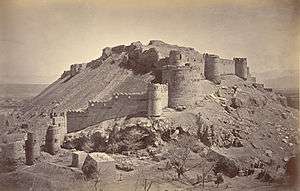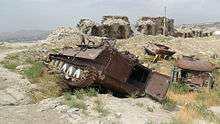Bala Hissar, Kabul
Bala Hissar ("High Fort") is an ancient fortress located in the south of the old city of Kabul, Afghanistan. The estimated date of construction is around the 5th century AD.[1] Bala Hissar sits to the south of the modern city centre at the tail end of the Kuh-e-Sherdarwaza Mountain. The Walls of Kabul, which are 20 feet (6.1 m) high and 12 feet (3.7 m) thick, start at the fortress and follow the mountain ridge in a sweeping curve down to the river. It sports a set of gates for access to the fortress. The Kōh-e Shēr Darwāzah (lion door) mountain is behind the fort.

Bala Hissar was originally divided into two parts: The lower fortress, containing the stables, barracks and three royal palaces, and the upper fortress (the actual fort with the name Bala Hissar) housing the armory and the dungeon of Kabul, known as the "Black Pit" (the Siyah Chal).
History


The Second Battle of Panipat was fought in 1556 between the forces of Akbar and Hemu, a Hindu king.[2][3] Hemu had the larger army, and initially his forces were winning, but during the Elephant charge he was wounded leading his forces by an arrow and taken prisoner.[2] When he was brought before the Mughal commanders, Bairam Khan killed him.[4] Hemu's head was sent to Kabul where it was hung outside the Delhi Darwaza of Bala Hissar, Kabul while his body was placed in a gibbet outside Purana Quila in Delhi to terrorise his remaining supporters.
As Kabul's principal fortress, Bala Hissar was an important site both in the First (1838–1842) and Second Anglo-Afghan War (1878–1880).[5]
The British envoy to Kabul, Sir Pierre Louis Napoleon Cavagnari was murdered inside the fort in September 1879 triggering a general uprising and the second phase of the Second Anglo-Afghan War.[5]
It was damaged during the Second Anglo-Afghan War when the British Residency was burned down, then later when the armoury exploded. General Frederick Roberts had wanted to level the fortress completely, but in the end it was strengthened and fortified in the Spring of 1880, a few months before the British left Afghanistan.[5]
20th century
On August 5, 1979, the Bala Hissar uprising was organized by anti-government groups, but it was suppressed and tens of people were arrested and executed by the regime.
Bala Hissar once again became the focal point of conflict between factions during the Afghan civil war in 1994, between Massoud's and Hekmatyar's forces. Much of the fortress was damaged as a result.
These days it is manned by the 55th Division of the Afghan National Army and one can see the remnants of tanks and heavy weapons positioned on the fortress remains overlooking Kabul.
Bala Hissar today
When looking at the outer wall of the main fortress, it is possible to see layers of building materials from years of destruction and re-fortification. The tanks and other war wreckage from the last 30 years are strewn about the top of the hillside. Much of the hillside is built up on tunnels and underground storage. Evidence of trenches from previous trench warfare encircles the upper most level of the hilltop, which is adorned with a rickety, stalwart Afghan flag. Wild dogs roam all over the hillside and a company from the Afghan Army is posted at the site. U.S. military and civilians occupied a site below the fortress during Operation Enduring Freedom. The occupants were warned when going up to the castle, to stay on the heavily used paths to avoid mines laid during the Soviet occupation.
.jpg)


Other locations by this name
- Bala Hissar is also a place in Mussoorie, India, where Dost Mohammad Khan was kept as prisoner by the British. This place falls part of the Wynberg Allen School estate.
- Bala Hissar Fort is a fortification built during the 18th Century in Peshawar, today in Pakistan, and rebuilt after destruction by the Sikh during the 19th Century.
References
- The British Library, Upper Bala Hissar from west Kabul. Retrieved 28 May 2012.
- Richards, John F. (1995) [First published 1993]. The Mughal Empire. The New Cambridge History of India. Cambridge University Press. p. 13. ISBN 978-0-521-56603-2.
- Kolff, Dirk H. A. (2002) [First published 1990]. Naukar, Rajput, and Sepoy: The Ethnohistory of the Military Labour Market of Hindustan, 1450-1850. Cambridge University Press. p. 163. ISBN 978-0-521-52305-9.
- Malleson, George Bruce (1890). Akbar and the rise of the Mughal Empire. Oxford: Clarendon Press. p. 71.
- Caption for Panorama of the Bala Hissar WDL11486 Library of Congress
